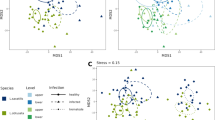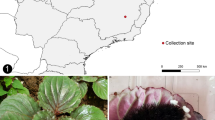Summary
Selected morphological and physiological properties of the corpus allatum (CA)-corpus cardiacum (CC) complex from the two-spotted stinkbug, Perillus bioculatus (Hemiptera: Pentatomidae), were studied. The CAs play an important role in insect physiology because of their production of the juvenile hormones (JHs), i.e., key hormones involved in development and reproduction. We found that the P. bioculatus CA-CC complex is present in two distinct morphological forms, the more frequently observed complex containing one “fused” CA between two CCs and the more rarely observed complex having one CA laterally attached to each CC. These complexes were tested for their ability to synthesize JH-like compounds. We found that the primary lipophilic compound synthesized by the CA-CCs migrated differently from JH III (a JH found in numerous insect species) when subjected to thin-layer chromatography. Furthermore, the synthesis of this compound is stimulated by 2E,6E-farnesol, a known precursor for JH III. These data indicate that the P. bioculatus CA-CC product has chemical properties similar to that of other (as of yet unidentified) hemipteran JHs. In addition, we found that the synthesis of this product is sensitive to pH and buffer type; minimally or not affected by the absence of the CC; expressed at similar levels in days 5–30 postemergent adults; and inhibited or decreased in adults reared under low temperature—short day conditions.
Similar content being viewed by others
References
Adams, T. S.; Filipi, P. A.; Yi, S.-X. Effect of age, diet, diapause and juvenile hormone on oogenesis and the amount of vitellogenin and vitellin in the twospotted stink bug, Perillus bioculatus (Heteroptera: Pentatomidae). J. Insect Physiol. 48:477–486; 2002.
Biever, K. D.; Chauvin, R. L. Suppression of the Colorado potato beetle (Coleoptera: Chrysomelidae) with augmentative releases of predaceous stinkbugs (Hemiptera: Pentatomidae). J. Econ. Entomol. 85:720–726; 1992.
Davey, K. G. Hormonal controls on reproduction in female Heteroptera. Arch. Insect Biochem. Physiol. 35:443–453; 1997.
Davey, K. G. The modes of action of juvenile hormones: some questions we ought to ask. Insect Biochem. Mol. Biol. 30(8–9):663–669; 2000.
Englemann, F. Hormonal control of arthropod reproduction. In: Epple, A.; Scanes, C. G.; Stetson, M. H., ed. Progress in comparative endocrinology. New York: Wiley-Liss; 1990:357–364.
Feyereisen, R. Radiochemical assay for juvenile hormone III biosynthesis in vitro. In: Colowick, S. P.; Kaplan, N. O., ed. Methods in enzymology. Vol. III. New York: Academic Press; 1985:530–539.
Feyereisen, R.; Tobe, S. S. A rapid partition assay for routine analysis of juvenile hormone release by insect corpora allata. Anal. Biochem. 111(2):372–375; 1981.
Gilbert, L. I.; Granger, N. A.; Roe, R. M. The juvenile hormones: historical facts and speculations on future research directions. Insect Biochem. Mol. Biol. 30(8–9)653–662; 2000.
Hammock, B. D.; Abdel-Aal, Y. A. I.; Mullin, C. A.; Hanzlik, T. N.; Roe, R. M. Substituted thiotrifluoropropanones as potent selective inhibitors of juvenile hormone esterase. Pestic. Biochem. Physiol. 22:209–223; 1984.
Hodkova, M.; Okuda, T.; Wagner, R. M. Stimulation of corpora allata by extract from neuroendocrine complex; comparison of reproducing and diapausing Pyrrhocoris apterus (Heteroptera: Pyrrhocoridae). Eur. J. Entomol. 93:535–543; 1996.
Hodkova, M.; Okuda, T.; Wagner, R. M. Regulation of corpora allata in females of Pyrrhocoris apterus (Heteroptera) (a mini-review). In Vitro Cell. Dev. Biol. 37A:560–563; 2001.
Hough-Goldstein, J. A.; McPherson, D. Comparison of Perillus bioculatus and Podisus maculiventris (Hemiptera: Pentatomidae) as potential control agents of the Colorado potato beetle (Coleoptera: Chrysomelidae). J. Econ. Entomol. 89:1116–1123; 1996.
Jones, G. L.; Yin, C.-M. Juvenile hormone biosynthesis by corpus cardiacum—corpus allatum complexes of larval Lymantria dispar. Comp. Biochem. Physiol. 92A(1):9–14; 1989.
Khan, M. A.; Doderer, A.; Koopmanschap, A. B.; de Kort, C. A. D. Improved assay conditions for measurement of corpus allatum activity in vitro in the adult Colorado potato beetle, Leptinotarsa decemlineata. J. Insect Physiol. 28:279–281; 1982.
Kotaki, T. Evidence for a new juvenile hormone in a stink bug, Plautia stali. J. Insect Physiol. 42(3):279–286; 1996.
Kotaki, T. A putative juvenile hormone in a stink bug, Plautia stali: the corpus allatum produces and releases a JH-active product different from any known JHs in vitro. Invertebr. Reprod. Dev. 31:225; 1997.
McNeil, J. N.; Maury, M.; Bernier-Cardou, M.; Cusson, M. Manduca sexta allatotropin and the in vitro biosynthesis of juvenile hormone by moth corpora allata: a comparison of Pseudaletia unipuncta females from two natural populations and two selected lines. J. Insect Physiol. 51:55; 2005.
Pratt, G. E.; Tobe, S. S. Juvenile hormone radiosynthesized by corpora allata of adult female. Life Sci. 14:575–587; 1974.
Rachinsky, A.; Hartfelder, K. In vitro biosynthesis of juvenile hormone in larval honey bees: comparison of six media. In Vitro Cell. Dev. Biol. 34A:646–648; 1998.
Richards, O. W.; Davies, R. G. Imms' general textbook of entomology. New York: John Wiley & Sons; 1977:276–277.
Tobe, S. S.; Pratt, G. E. The influence of substrate concentrations on the rate of insect juvenile hormone biosynthesis by corpora allata of the desert locust in vitro. Biochem. J. 144:107–113; 1974.
Trautmann, K. H.; Masner, P.; Schuler, A.; Suchy, M.; Wipf, H. K. Evidence of the juvenile hormone methyl (2E,6E)-10,11-epoxy-3,7,11-trimethyl-2,6 dodecadienoate (JH-3) in insects of four orders. Z. Naturforsch. 29C:757–759; 1974a.
Trautmann, K. H.; Schuler, A.; Suchy, M.; Wipf, H.K. Eine methode zur qualitativen und quantitativen Bestimmung von drei Juvenilhormonen von Insekten. Nachweis von 10,11-Epoxy-3,7,11-trimethyl-2-trans-6-trans-dodecadiensauremethylester in Mellontha melolontha. Z. Naturforsch. 29C:161–168; 1974b.
Wigglesworth, V. B. Historical perspectives. In: Kerkut, G. A.; Gilbert, L. I., ed. Comprehensive insect physiology, biochemistry and pharmacology. Vol. 7. Oxford: Pergamon Press; 1985:2–24.
Woodring, J.; Hoffman, K. H. Apparent inhibition of in vitro juvenile hormone biosynthesis by the corpus cardiacum of adult crickets (Gryllus bimaculatus and Acheta domesticus) is due to juvenile hormone esterase. Arch. Insect Biochem. Physiol. 34:19–29; 1997.
Yagi, K. J.; Tobe, S. S. The radiochemical assay for juvenile hormone biosynthesis in insects: problems and solutions. J. Insect Physiol. 47:1227–1234 2001.
Author information
Authors and Affiliations
Corresponding author
Rights and permissions
About this article
Cite this article
Goodman, C.L., Wagner, R.M., Nabli, H. et al. Partial morphological and functional characterization of the corpus allatum-corpus cardiacum complex from the two-spotted stinkbug, Perillus bioculatus (Hemiptera: Pentatomidae). In Vitro Cell.Dev.Biol.-Animal 41, 71–76 (2005). https://doi.org/10.1290/04070511.1
Received:
Accepted:
Issue Date:
DOI: https://doi.org/10.1290/04070511.1




